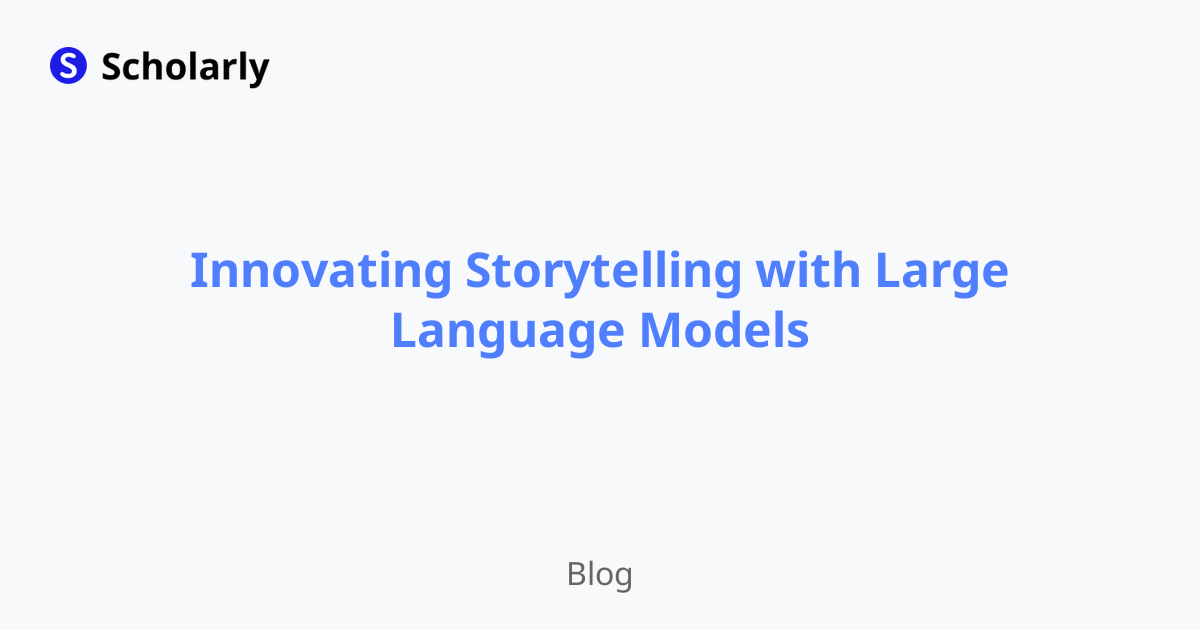Innovating Storytelling with Large Language Models
Explore the revolutionary merging of large language models with traditional storytelling, examining how AI shapes narratives. Uncover the past, current, and future states, the benefits and significance, best practices, and the challenges faced when innovating storytelling with cutting-edge technology. Dive into comparisons, methods, AI impact, and common techniques. Discover potential online apps, including Scholarly, that enhance this integration for creators and audiences alike.

Introduction
Storytelling is an ancient art that has evolved with humanity, and with the advent of large language models (LLMs), we are on the cusp of a narrative revolution. This post will guide you through the historical context, benefits, significance, and practical applications of innovating storytelling with LLMs. We will delve into the pros and cons, compare tools, explore methods, and assess the impact of AI on storytelling. Additionally, we will examine common techniques and challenges, as well as potential online applications like Scholarly.
History
Past State
Once upon a time, storytelling was an oral tradition, with stories passed down through generations. As time progressed, so did the mediums - from the written word to digital storytelling platforms. Traditional tools like typewriters and manuscript paper gave way to word processors and creative writing software. Today, we see a new chapter with the integration of artificial intelligence.
Current State
In the present, digital platforms have embraced AI, with tools like Scholarly offering innovative features such as AI-generated text completion and study flashcards. Creatives can utilize these functionalities to refine their narrative techniques and engage more deeply with their audience. As LLMs become more sophisticated, they are increasingly assisting in the crafting of complex and compelling stories.
Future State
Looking ahead, we see a horizon where AI not only aids but potentially co-creates with human storytellers. Imagine a future where LLMs generate not just text, but whole narrative arcs, character development, and intricate plots, all while learning from and adapting to the nuances of human emotion and storytelling. This collaboration could redefine storytelling as we know it.
Benefits
Enriched Creative Process
The integration of LLMs into storytelling enriches the creative process. By offering suggestions and generating content, AI allows storytellers to break free from writer's block and explore new narrative possibilities.
Enhanced Engagement
Stories crafted with the aid of AI can become more dynamic, interactive, and personalized, leading to enhanced engagement from the audience. AI-driven analytics can help understand reader preferences, tailoring stories to meet the collective palate.
Significance
The significance of merging LLMs with storytelling lies in the potential to democratize creativity. By lowering the barrier to entry, AI can unleash a wave of diverse, untold stories that might have otherwise remained hidden. The historical context of storytelling underscores this transformative potential.
Best Practices
Embrace Collaboration
AI should be viewed as a collaborative tool, not a replacement for human creativity. By working in tandem with AI, storytellers can craft richer narratives.
Balance Human Touch
While AI can offer vast possibilities, maintaining the human touch in storytelling ensures authenticity and emotional resonance. Stories should reflect the human experience, with AI serving as an enhancer, not the sole creator.
Pros and Cons
Pro: Innovation
AI brings innovation to storytelling, pushing boundaries and exploring new forms of narrative expression. It encourages writers to experiment with different styles and genres.
Con: Overreliance
An overreliance on AI risks losing the personal touch that defines great stories. Writers must ensure that their voice remains prominent, with AI as an assisting tool.
Comparison
Scholarly
Among the tools leveraged for innovating storytelling, Scholarly stands out with its comprehensive suite of AI-powered features, providing a seamless experience for writers and students alike. It offers a space for integrating text, images, and flashcards, allowing for diverse narrative experimentation.
AI Impact
AI Applications
The application of AI in storytelling ranges from idea generation to narrative analysis. AI can help identify plot patterns, suggest improvements, and simulate reader response.
Common Techniques
Utilizing AI Prompts
One common technique is using AI-generated prompts to kickstart the storytelling process. This can lead to unexpected and original story directions.
Challenges
Ethical Considerations
The use of AI in storytelling brings ethical considerations to the forefront. Ensuring that AI-generated content respects copyright agreements and the integrity of original ideas is paramount.
Potential Online Apps
Scholarly
With features like TTS and the ability to transcribe pictures to text, Scholarly provides writers with powerful tools to enhance their storytelling process. Its AI-driven flashcard and text generation also aid in organizing and structuring narrative elements.
More Subheadings
The Role of AI in Character Development
AI can play a pivotal role in developing nuanced and multifaceted characters by suggesting traits, backstories, and character arcs based on vast literary databases.
AI-Enhanced World-Building
AI's capacity to cross-reference and simulate worlds based on complex variables can drastically expand a writer's ability to build believable and rich story settings.
Conclusion
Innovating storytelling with LLMs marks a new era in creative expression. We've explored the historical context, benefits, significance, and best practices, alongside the pros and cons, tool comparisons, AI impact, common techniques, challenges, and potential online applications like Scholarly. These elements collectively represent a seismic shift in how stories are told and enjoyed. By harnessing AI's power responsibly, storytellers can unlock unprecedented potential and shape the narratives of the future.
Try Our Popular AI Study Tools
Transform your study materials into interactive learning experiences with our most popular AI-powered tools:
PDF to Flashcards
Convert lecture notes and textbooks into study flashcards instantly
Text to Flashcards
Turn any text or notes into comprehensive flashcard sets
Image to Flashcards
Convert diagrams and handwritten notes into digital flashcards
YouTube to Flashcards
Generate flashcards from educational video content



